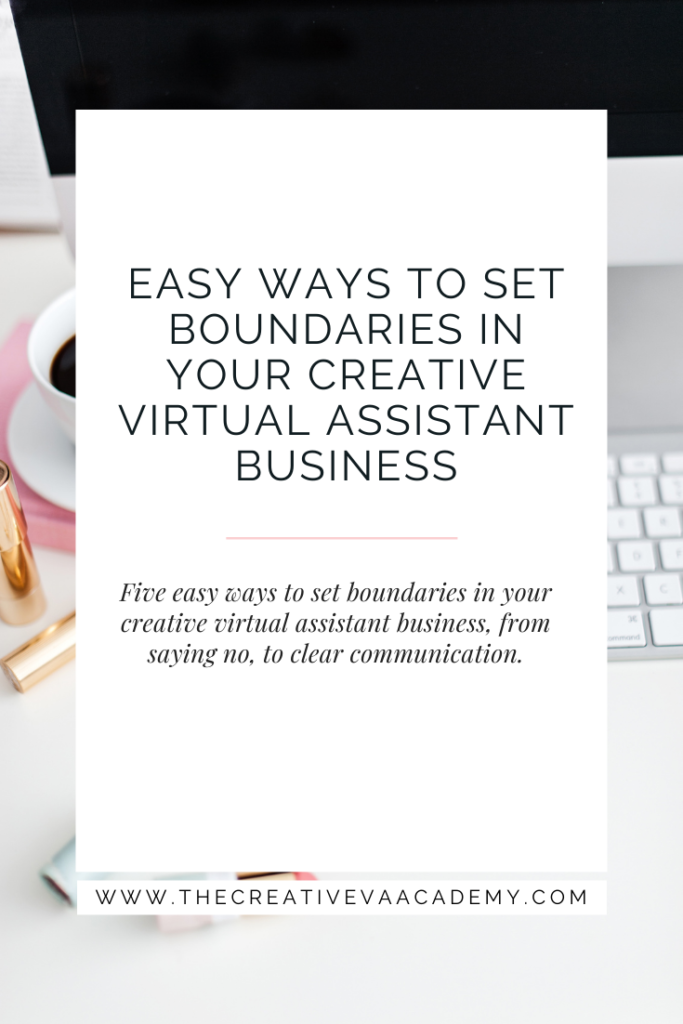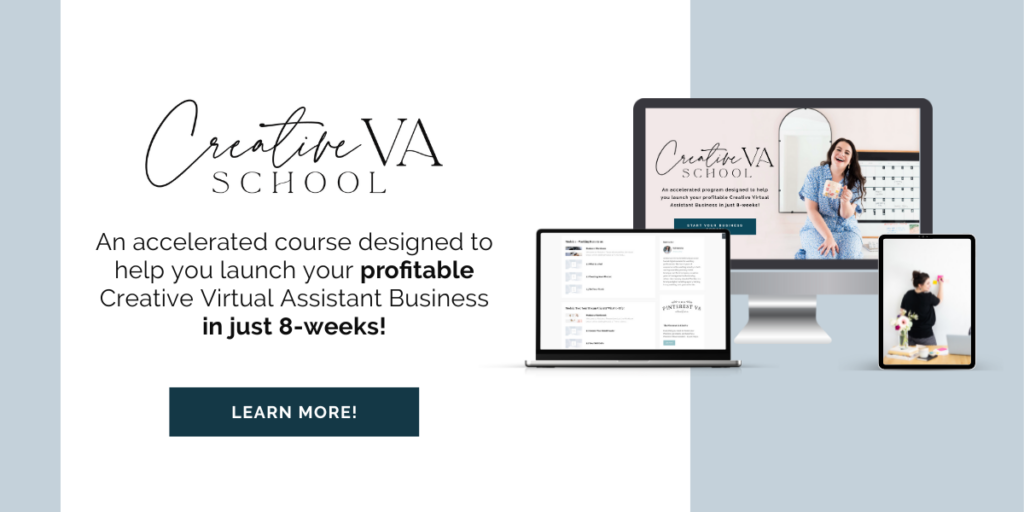Easy Ways to Set Boundaries In Your Creative Virtual Assistant Business
March 1, 2022
Boundaries are one of the most important things you need in your creative virtual assistant business. Boundaries are when you set clear outlines and expectations in your business, and communicate this with your clients. When you work with clients you want to make sure you establish boundaries early on in the relationship so your client goes in knowing what to expect from you in terms of communication and workflow.
How many times have you found yourself working at 10 PM on a Friday night because that client, you know the one, needed their items by Monday morning… but sent the information at 4 PM that day. Or the client who needs just one more little thing done before the end of the day – they think it should just take a few minutes right?
How often to budge for clients like these? How often do you find yourself working later hours than you planned on, or working all day Sunday instead of enjoying your weekend with your family? This is something we have all experienced in both our personal and work life. This is why I want to go over boundaries!
Why Boundaries Are Important
One of the hardest parts of working for yourself is this: setting boundaries with your clients. That is why it is important to set these as soon as possible in your business, instead of midway through working with a problem client.
Not setting boundaries with your clients is not just a disservice to you – but to them. You can’t do your best work for any of your clients if you are jumping to meet client demands outside of your boundaries. This also trains your client to expect this from other freelancers as well, and that contracted workers and freelancers are expected to work all hours of the day. Plus, it trains them to expect more from you. If you budge once and do a last-minute project with no rush fee, they will expect you to do it again and again.
Boundary #1: Outline Communication
Always outline when, and how, you are available for communication. Your hours might vary and not be the standard 9-5 Monday – Friday. So make sure they know! Even if your hours are standard, have them aware of this. This will ensure they know when they will hear back from you on any issues!
Also, have it known when you will respond back – I recommend stating to expect at least a 24-48 response time for all emails. You can always workout side of these hours – but all client communication will be during these hours only.
Have this information in your contract, in your welcome packet, and in your email signature.
Boundary #2: Modes Of Communication
I encourage you to have your main point of communication be through emails- NOT texting or phone. Even when I was a wedding planner, the client did not get my cell phone until 3 days before their wedding. This ensured that all emergencies were handled at work.
By giving your phone number for them to text or call at all hours, you are eliminating your office hour boundaries. If a client texts me, I email them back with a response. I don’t text them back! This shows them that I want all communication to be through email, not text.
Get a Google Voice Number. This is a free service that allows you to forward that number to your cell phone. Your client will have a number on hand, but you will know if a call comes through Google Voice that it is for work- and let you decide if you answer.
If your clients have a service like Slack or Voxer or Marco Polo, have set hours you will be available on there. Don’t just let them assume the minute they send you a message that you will be at your desk responding. You can outline this in your contract or welcome packet. I have one client where I am one of many subcontractors, so they use slack. They know that I am available on slack from 10 AM-12 pm every day and that is it. Outside of those hours, it needs to be via email.
Boundary #3: Set Office Hours
Even if you work a full-time job at the moment, and work at night, set office hours! In this digital age, it can be easy to send an email at any hour of the night, but do not do this. By sending emails outside of your office hours you are showing your client that you are working, and available.
If you have a response, set it as a draft, and email it during office business hours. Or get a plugin for Gmail like Boomerang– this is a free tool that allows you to send an email at any time! I might be working late, but I never send an email past 5:30 PM. I always schedule it in boomerang to go out at 9 AM the next day.
When you go away, have an auto-responder turned on. I have in my responder that if a client’s concern is urgent, and needs attention right away, to put URGENT in the subject line. This way I know to look at the email. Other than that, do not feel the need to respond!
Boundary #4: Extra Work Is NOT FREE
Oh boy, is this one a biggie. Extra work is not free. I want you to say this out loud: extra work is not free. I know I am guilty of offering free work again and again and let me tell you, it is a hard habit to break! So start by setting these guidelines NOW.
Your clients are human: they will ask for free work from time to time. Even if it is just “one extra Instagram post this week” or “10 more photos edited”, or “30 more minutes of work this month” they will ask. And you need to have a way to say no. If your clients ask for anything outside of the scope of the project, you need to charge. No matter how big or small.
Always have this in your contract: that extra work outside of the scope of the agreed-upon project will be subject to additional fees. This fee is up to you. I suggest having it be your hourly rate, and charge a minimum of 1 hour. Also, do not feel obligated to take on this extra work. If you do not have it in your bandwidth, it is okay to tell the client no. Or that you can’t do it until a later date.
If you can take on this additional work respond with:
“Yes, I would be happy to do this for you! I can get to this sometime later this week. It will be an additional [insert price here] to do [insert what they want here]. Let me know if you would like me to add this to your invoice.”
If you can’t take on this additional work respond with:
“I am not able to take on this additional work at this time. I will be able to take on this project at [insert the date here] for [insert the price here]. Would you like me to add that to the next invoice?”
Boundary #5: Learn to say No.
Saying no will be your best friend in your new business. I’ll admit, this is one of the hardest ones for me! This can be a challenge, especially when the people-pleaser in us starts showing up. But, it will benefit you and your business so much more in the long run to be completely honest about what you can and can’t help people with, as well as what feels aligned in your business.
If an inquiry gives you bad feelings or red flags – say no.
If an inquiry is negotiating your pricing – say no.
By setting these boundaries now, you are ensuring a successful working relationship with your client!

